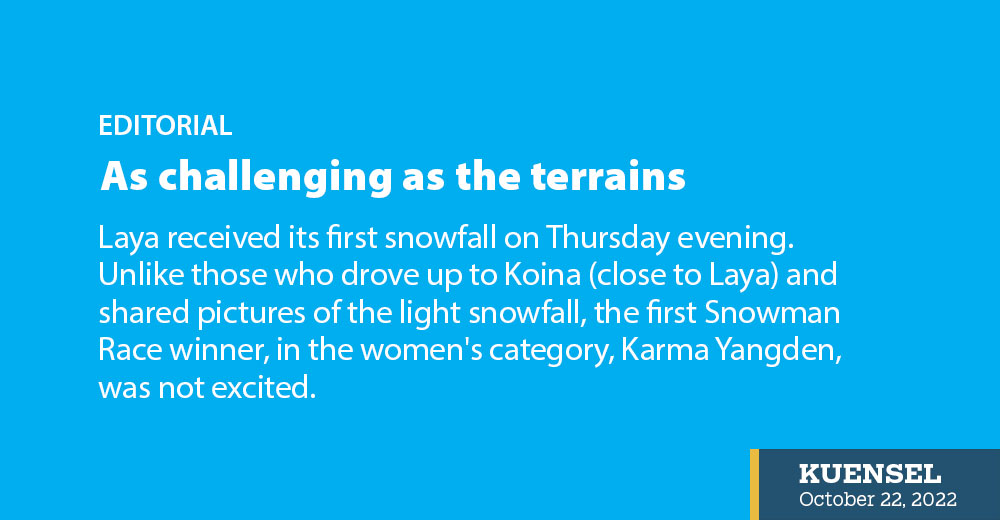Laya received its first snowfall on Thursday evening. Unlike those who drove up to Koina (close to Laya) and shared pictures of the light snowfall, the first Snowman Race winner, in the women’s category, Karma Yangden, was not excited.
She knows her place well.
Karma is a villager at 3,820 metres above the sea level. Running and scaling the highest point, 5,470 masl, may not be a big deal for her. Climate change and calling for action, for her, could have been only a part of the tough competition.
Karma and her neighbours, however, are feeling the heat.
At a dinner hosted for the runners, partners and organisers in Thimphu, Karma surprises an official who, in a tone claimed to know Laya well, asked if she would come to Punakha soon.
Many Layaps stay home in winter these days, according to Karma. She may be not aware of the science behind the change, but she feels Laya is becoming warmer in winter and snowfall thinner. Layaps migrate to the Punakha-Wangdue valley to escape the harsh winter.
“It is changing. We stay back to harvest grass from the mountain sides where our cattle cannot climb,” she says. What is changing is also the climate.
As ice thaws faster in winter, there is more drinking water in Laya. New vegetables can be grown so do new invasive weed species. Some call it Jagar yoelma (Indian weed). It is change, indeed, if the weeds grown in the Himalayan foothills are invading Layap gardens.
Karma will go back home today with her certificate and the awards. The Bhutanese winners would join their duty soon. The other participants are leaving or have left Bhutan after taking part in the world’s toughest race.
The Snowman Run, an inspiration of His Majesty The King to draw the world’s attention to climate change, an SOS agenda in our times, was scheduled in the fall of 2020. The Covid-19 pandemic disrupted the schedule. It (the delay) was a blessing in disguise.
In the last year, we witnessed how human induced climate change has affected the world – from Asia to Americas, Africa to Europe and to the poles, north and south. Looking back , all we remember are the heatwaves, floods, droughts, cyclones and typhoons beside the ongoing Russian invasion of Ukraine and the impending global economic crisis.
At home, like Karma complaining of decreasing Cordyceps yield or enjoying warmer winters in the highlands, the impact of climate change is becoming clearer.
Unfortunately, it is not in our hands to revert change. At our level, the wise leadership and farsightedness of our monarchs have recognised these problems decades ago. We are one of the few countries that is carbon negative. Conserving or protecting the environment is mandated by the Constitution. However, in a globalised world, what we do is not enough.
An increase in global temperature would mean our glaciers – source of fresh water and to turn the turbines – will retreat risking glacial lakes to burst and cause loss to life and property. We are located in the young Himalayas where scientists say is the most vulnerable from the impact of climate change.
The Snowman Race is not just a sporting event. It is an event to draw the attention of world leaders to an emergency. The hope is that when the international participants reach home, they will share the first-hand experience of the impact of climate change beside the memories and the photos.
The hope is that the world and the leaders will listen to the stories and impact policies. It may be as tough as the Snowman Race, but it is a small step from a small country to highlight a global problem.
Hopefully, there will be listening ears and the challenge will not be as difficult as running across the Bhutanese mountains.


